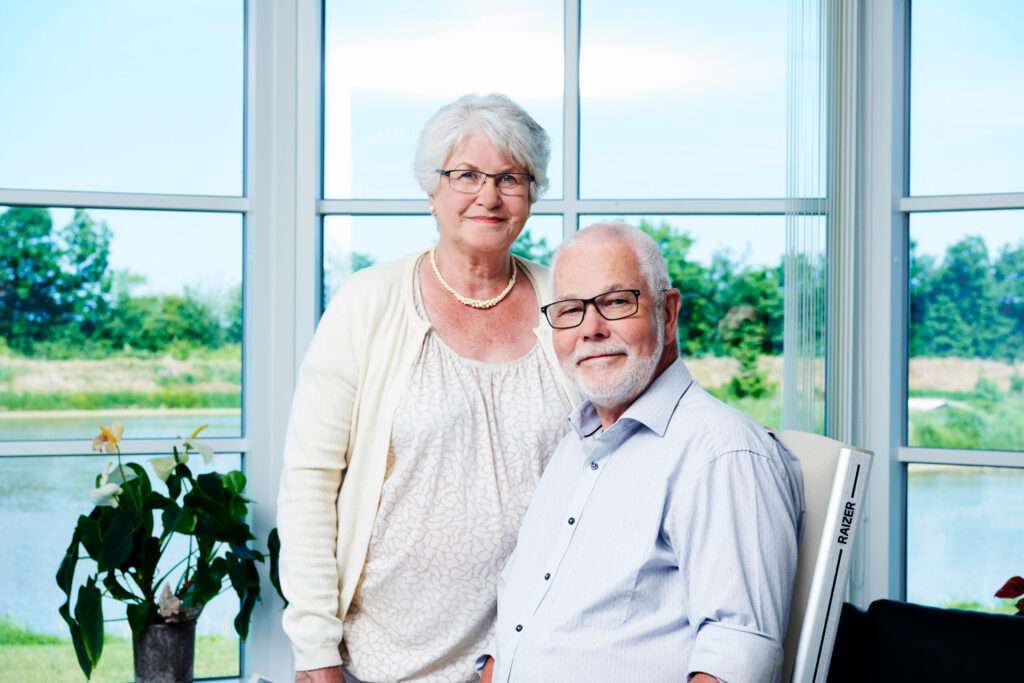Falls in the home can be a frightening experience, both for those who have fallen and their carers. With no trained staff on hand to help, it is important that an effective solution exists which allows people to get up quickly without having to call the emergency services.
Fortunately there are products available that make this possible – but what should you look for when selecting one of these devices?
In this blog post we explore ‘the best falls lifting devices for home use’, examining how they work and providing advice on choosing between them.
We’ll discuss the pros and cons of the Raizer II, the Raizer M, the Mangar Lifting Cushions including the Elk & Camel & Eagle and mobile hoists with slings. So if you’re looking into solutions for falls at home then read on!
For full disclosure, as a company we have been selling the Raizer falls lifting devices since they were first invented; however until fairly recently we were also distributors of the Mangar lifting cushions for many years, and still offer mobile hoists and slings, so are fully aware of the features and benefits of each.
In this guide, we’ll be open and honest about each product’s pros and cons so you can make your own informed and unbiased opinion!
Table of Contents:
- Falls lifting products ratings summary for home use
- Dealing with falls at home
- The different types of falls lifting devices
- Conclusion
Falls patient lifting products for home use ratings summary:
Dealing with falls at home
Before we delve into the different products available for lifting fallen people from the floor, let’s look at why falls happen at home in the first place, what we can do to prevent them, and why we should look at using falls lifting devices rather than calling for an ambulance.
How can falls happen in a private house?
Falls can happen in a private house for many reasons. The most common causes of falls at home are tripping, slipping, and losing balance. Trips can occur due to objects left on the floor or uneven surfaces such as carpets that have become bunched up or raised.
Slips may be caused by wet floors from spills or water tracked in from outside. Loss of balance is usually due to age-related issues like poor vision, weakened muscles, impaired coordination, dizziness, and medications that cause drowsiness.
How to prevent falls at home
Falls are a common cause of injury and hospitalization among the elderly. Falls can occur anywhere, but they are especially dangerous when they happen at home. Fortunately, there are several steps you can take to reduce your risk of falling in your own home.
Start by assessing your environment for potential hazards that could lead to falls. Look around for items like cords that may be tripping hazards, and make sure any furniture is stable and secure so it won’t tip over if someone leans on it too hard.
Make sure all stairways have handrails installed securely on both sides and check regularly to ensure nothing has become loose or broken.
Rugs should be secured firmly onto the floor using double sided tape if necessary so they don’t bunch up, causing someone to trip over them while walking through a room.
Floors should be kept dry at all times by wiping up any spills immediately after they occur, and by placing mats near entryways where people will track in moisture from outside shoes during rainy weather conditions.
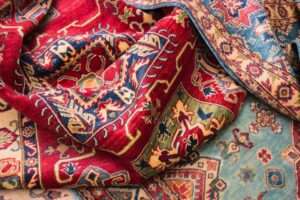
Ruckled up rugs can be a trip hazard, so make sure they are fastened down with double sided tape.
Another important step is to create a safe space free from clutter where you can move around freely without worrying about bumping into things or having something fall on top of you unexpectedly.
This means keeping walkways clear of objects such as shoes, toys, books, etc., as well as making sure any furniture is arranged in a way that allows plenty of room for manoeuvring between pieces without having to squeeze through tight spaces or climb over obstacles.
To prevent falls at home, it is important to take safety precautions such as clearing clutter, installing grab bars and ensuring that rooms and passageways are well lit. These measures can help reduce the risk of falling, but when a fall does occur, being able to quickly and safely lift the person from the floor can be beneficial in many ways – let’s explore this further.
Key Takeaway: Falls can be prevented by assessing the home environment for potential hazards, such as loose rugs or cords, and creating a safe space free from clutter to allow for easy movement.
The benefits of being able to patient lift from the floor instead of calling emergency services
You may ask, why not just call for an ambulance when someone has fallen? There are many reasons why this might not be the best option. However, it’s important to note that if the faller has been injured, it is best to call 999.
Falls are typically treated as ‘Category 4’ calls. This is the lowest priority of ambulance callouts, meaning that if the service is busy or another call comes in on the way to your call, they will get diverted.
This often means that your family member or friend is stuck lying on the floor for many hours. Quite aside from the stress, discomfort and inconvenience this can cause, this can often lead to other issues.
If the fallen person is on the floor for over an hour, this is known as a ‘long lie’. This can have significant consequences, as is shown below:
“Lying on the floor for a long time was strongly associated with serious injuries, admission to hospital, and subsequent moves into long term care.”
Another study put it even more starkly:
“Fallers who were unable to get up were more likely to die, to be hospitalized, and to suffer a decline in activities of daily living for at least 3 days”
If the person has poor skin, has had a history of tissue damage, or has muscle or tissue wastage then they may be at risk of pressure damage when lying on a hard surface.
Pressure sores, or ‘bed sores’ as they can be known, are very painful and can cause all sorts of other complications. The cost of treating pressure ulcers is significant, and it can be a cause of mortality.
Even complications such as dehydration and incontinence can occur during a long lie.
What should you look for in a falls patient lifting product for use at home?
When looking into purchasing a falls patient lifting product it is important consider factors such as weight capacity, size, ease of use, portability, storage requirements, cost effectiveness, and safety features.
Older people living at home are typically living with their partner or spouse, so the device needs to be able to be used by one person. It’s also important to consider how easy the product is to use, particularly in a stressful situation after someone has fallen.
It’s always good to ask how much manual handling of the person will be required to get the person onto the device.
You may also want to consider storage and charging of the product, to ensure it will be ready to use and easy to grab when needed.
Key Takeaway: It is important to consider factors such as weight capacity, size, ease of use, portability and safety features when choosing a falls lifting device for home use in order to ensure safe and effective operation.
The different types of falls patient lifting devices for home use
Without further ado, let’s have a look at each of the options in order. It’s important to note that this is our recommended directory of products to use in a home setting.
For hospitals, care homes, emergency services, and multi-user care environments, there are also a few other options available, such as supine flat patient lift products, however as these are so bulky or require specialist care team input, they’ve not made it onto this list.
Raizer II
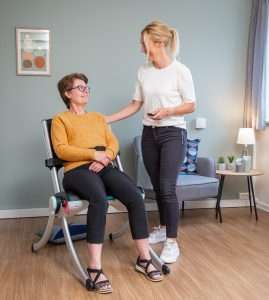
The Raizer II can be used quickly and safely to lift a fallen person in under a minute!
Whilst Raizer II is used by professional care staff and paramedics throughout the world, it’s also incredibly popular for use by private individuals in the home, as it’s so easy and quick to use.
The Raizer II is easy to transport, making it ideal for use in private homes, and even has an optional trolley if you find it heavy to lift. It can be assembled by one person without assistance, allowing frail carers or those with limited mobility to easily set up the device when needed. What’s more, no manual handling or hard work is required by the person doing the lifting.
The patient lift chair works using a battery (which lasts for circa 80 lifts on one charge!), a motor unit, and a remote control. It comes complete with a seat unit cover, backrest, seat belt, and charger, and an optional head support is available as an accessory.
The advantages of using this product in the home are numerous, such as a decreased risk of injury due to incorrect manual handling techniques; quicker response times than waiting for emergency services; less reliance on family members or other helpers; improved comfort levels during transfer and increased independence for those with limited mobility issues who may otherwise require assistance getting up off the floor after falling down unexpectedly.
The Raizer II is a great choice for home use, offering a safe and quick way to lift fallen people from the floor. Now let’s take a look at the Raizer M – another similarly innovative falls lifting device.
Key Takeaway: The Raizer II falls lifting device offers a fast and safe way to lift people from the floor, providing increased independence for those with limited mobility and reducing strain on carers.
Raizer M
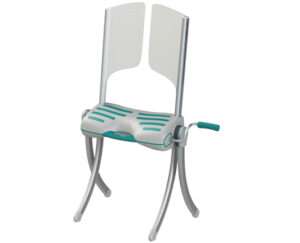
The Raizer M assembles together around the fallen person, and has a crank handle on the side to lift them to a seated position.
Raizer M is a falls lifting device designed for use in the home. Like the Raizer II, it can be operated by one person, however the Raizer M is a fully manual solution, with no battery or motors.
Instead, it features a manual winding action which allows you to adjust the height of the lift as needed. You might think this sounds difficult to do, but the reality is that due to its gearing, the winding action is incredibly free and easy — much like putting pasta through a pasta machine and winding the handle!
The lightweight design makes it easy to operate and its well-priced nature makes it a great choice for those looking for an affordable solution.
When considering what type of falls lifting product would best suit your needs, there are several factors to consider such as safety, ease of use, cost effectiveness and stability of the lift itself.
With Raizer M, all these criteria have been taken into account so that users can feel confident when using this device at home with their loved ones who may have fallen down unexpectedly due to age or illness related issues.
In addition, Raizer M comes with additional accessories such as a seat belt which help secure someone during the lift from the floor – ensuring maximum safety throughout each step of operation process. A headrest is also available, as is a trolley to enable easy transportation.
Finally, the compact size means that it won’t take up too much space in your house, and as it is a manual operation, you never have to worry about if it has enough charge or if it is ready for use or not.
All these features make Raizer M an ideal choice for anyone looking for reliable fall prevention solutions at home.
There are, however, two points to note when it comes to the Raizer M:
- The repetitive action of winding the handle may not always be the best option for spouses or carers with issues such as arthritis.
- Due to the crank handle, you do need a bit more space on one side of the person who has fallen, so if your house has a lot of small spaces or narrow corridors, this could be an issue.
For those who are concerned about the above two potential disadvantages, then consider the battery-powered Raizer II device instead.
In summary, the Raizer M is an innovative device that allows a single carer to quickly and safely lift someone who has fallen from the floor with minimal effort. Now, let’s take a look at another option: Mangar Lifting Cushions.
Key Takeaway: Raizer M is a safe, easy to use and cost-effective falls lifting device with a manual hand crank operation, making it an ideal choice for home use.
Mangar Lifting Cushions
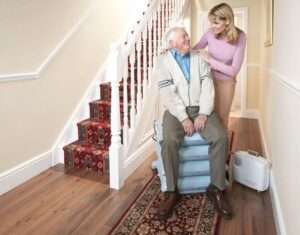
The Mangar Elk is an air inflatable air cushion, which you position under the patient and then inflate to bring them to a sitting position.
Mangar Lifting Cushions are a great solution for those who need help lifting someone from the floor. These cushions are designed to be used in any environment using an air compressor which comes with it.
There are three models — the Elk, which doesn’t have a backrest, the Camel, which is a large cushion with a backrest, or the Eagle, which has a backrest but isn’t as bulky as the Camel.
For home use, for those looking at the inflatable cushion option, we would typically recommend the Elk if you are concerned about cost, or the Eagle if possible due to the extra support the backrest offers. The Camel is better for larger users or heavy duty use, so can be rather difficult to use in smaller rooms at home!
The Mangar Lifting Cushions are reasonably cost effective compared to other devices on the market, and they can lift heavier people than most alternatives. It is also relatively easy to use; however, there are some drawbacks that should be taken into consideration before purchasing this product.
It requires an air compressor and thus is quite noisy when in operation which may not be suitable for certain environments or situations. Furthermore, manual handling is necessary to get it underneath the person being lifted, so it may not be ideal if the person operating it has limited mobility or frailty.
Additionally, due to the inherit instability of air devices, more than one person might have to operate this device and offer support to the fallen person as they rise to a sitting position – making it less practical if only one carer is present at any given time.
When considering whether or not Mangar Lifting Cushions are right for you or your loved ones’ needs, take into account all of their pros and cons so that you can make an informed decision about what type of falls prevention device will best suit your situation.
Consider the cost effectiveness compared to other devices on the market, as well as any drawbacks such as noise levels, the lengthy process it takes to set it up and carry out the lift and pack it away, the manual handling requirements, and the number of people needed to operate it.
This way you can ensure that you have chosen a product that is both safe and effective for lifting someone from the floor.
Mangar Lifting Cushions provide a safe and easy way to lift someone from the floor without putting strain on the carer’s back. Next up, we’ll look at how Mobile Hoists with Slings can help reduce falls in the home.
Key Takeaway: The Mangar Lifting Cushion is a cost-effective and efficient solution for lifting someone from the floor, but one must consider its noise levels, time to use it, manual handling requirements and number of people needed to operate it before making a purchase.
Mobile Hoist with Sling
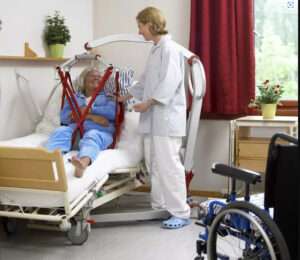
There are all sorts of mobile hoists, which use a sling as a ‘hammock’ to lift the person.
Mobile hoists with slings are a solution for lifting people from the floor safely and quickly in a private home. These devices can be operated by one person, using a sling attached to a hoist which lifts the person up from the floor with minimal effort required from the carer.
The main advantage of this type of device is that it is cost effective and easy to transfer patients into chairs or wheelchairs after they have been lifted.
However, there are some drawbacks associated with mobile hoists with slings. Firstly, they can be difficult to use if you don’t have any prior experience or training in how to operate them correctly and safely. Secondly, if not used properly these devices can become unsafe for both patient and carer alike. Lastly, they can be difficult to store due to their size and weight.
So if you don’t have a mobile hoist at home already, we wouldn’t recommend you to go out and buy one. However, if you have one at home and are familiar in its use, then it could become your go-to option for falls recovery.
Key Takeaway: A mobile hoist with sling for can be an option for falls in the home, but really only if you already have one and are familiar with how to use it. Consider safety features, weight and warranty when looking at this as a potential solution, as well as training requirements to ensure maximum safety.
Conclusion
When it comes to the best falls lifting devices for home use, there are a few options available. The Raizer II and M offer easy one-person operation and portability, while Mangar’s Lifting Cushions provide an effective alternative for those with limited mobility. Finally, a mobile hoist with sling is an option for those who already have a hoist in their home.
Ultimately, choosing the right device depends on individual needs and preferences. It is important to consider all of these factors before making your decision in order to ensure that you have chosen the most suitable product for your situation.
If you are considering one of the Raizer products, then please do get in touch, as we offer a ‘Money Back Guarantee’, allowing you to try out the product for yourself in your own home. Alternatively, we can carry out a no-obligation demonstration — either in your own home or by video on Zoom or Microsoft Teams.





